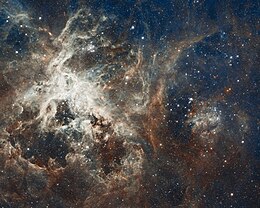蜘蛛星云
| 星云 | |
|---|---|
 | |
| 观测资料: J2000 epoch | |
| 赤经 | 05h 38m 38s[1] |
| 赤纬 | -69° 05.7′[1] |
| 距离 | 160 ± 10 k 光年 (49 ± 3[2][3] k 秒差距) |
| 视星等 (V) | +8[2] |
| 视尺度(V) | 40′ × 25′[2] |
| 星座 | Dorado |
| 物理性质 | |
| 半径 | 931[2][4] ly |
| 值得注意的特征 | In LMC |
| 名称 | NGC 2070,[2] Doradus Nebula,[1] Dor Nebula,[1] 30 Doradus |
蜘蛛星云(也被称为剑鱼座30)是大麦哲伦星系(LMC)中的一个巨大电离氢区。以地球的视角观察,它形成大麦哲伦星系的东南角。
发现
[编辑]蜘蛛星云是由尼古拉-路易·德·拉卡伊于1751年至1753年期间,在对好望角的探险中观察到的。他将其归类为“第一类星云”中的第二个,是“在口径2英尺的望远镜中看不到任何恒星的星云”。它被描述为一个20弧分的弥散星云[5]。
约翰·波德在他1801年的“波德星图”就中包括了蜘蛛星云,并在随附的“星星的一般描述和证据”星表中将其列为“剑鱼座30”。它没有被赋予恒星星等,而是被注意到是模糊的云气[6]。
在20世纪中叶,源于它在深度摄影曝光中出现的形象,出现了“蜘蛛星云”这个名字[7]。
剑鱼座30[锚点失效]经常被视为恒星的名称[8][9],或是NGC 2070中央的星团[10],但现在通常被视为是蜘蛛星云的整个星云区域[11][12]。
特征
[编辑]
蜘蛛星云的视星等为8等。考虑到它的距离约为49 千秒差距[2] (160,000光年),这是一个非常明亮的非恒星天体。它的光度是如此之大,以至于如果它像猎户座星云一样靠近地球],蜘蛛星云就会投射出可见的影子[13]。事实上,它是本星系群的星系中已知最活跃的星爆区。
它也是本星系团中最大的电离氢区域之一,估计直径约为200至570 pc(650至1860光年)[2][3],而且因为它的尺寸非常大,它有时被描述为最大的,尽管其它电离氢区,例如位于三角座星系的NGC 604,可能更大[3]。蜘蛛星云位于 LMC 的前缘,那里的冲压力剥离,可能由此导致星际介质的压缩达到最大值。
NGC 2070
[编辑]
剑鱼座30的中心是星团NGC 2070,其中包括被称为R136的恒星紧凑聚集地[14]。这产生了使星云可见的大部分能量。估计该星团的质量为450,000太阳质量,这表明它在未来可能会成为一个球状星团[15]。除了NGC 2070之外,蜘蛛星云还包含许多其他星团,包括更古老的霍奇301。霍奇301中质量最大的恒星已经爆炸成为超新星了[16]。
超新星1987A
[编辑]自望远镜发明以来观测到的最接近的超新星[17] SN 1987A,发生在蜘蛛星云的郊区[18]。有一个显著的超新星遗迹包围著疏散星团NGC 2060,但是许多其它超新星的残馀物很难在复杂的星云中探测到[19]。
黑洞VFTS 243
[编辑]在蜘蛛星云中发现了一个X射线安静的黑洞,这是银河系之外第一个没有强烈辐射的黑洞。这个黑洞的质量至少为9个太阳质量,与它的伴星VFTS 243,25个太阳质量的蓝巨星处于圆形轨道上[20]。
相关条目
[编辑]参考资料
[编辑]- ^ 1.0 1.1 1.2 1.3 NAME 30 Dor Nebula. SIMBAD. 斯特拉斯堡天文资料中心.
- ^ 2.0 2.1 2.2 2.3 2.4 2.5 2.6 Results for Tarantula Nebula. SEDS Students for the Exploration and Development of Space. [2007-05-08].
30 Doradus .. 49 kpc +- 3 kpc
- ^ 3.0 3.1 3.2 Lebouteiller, V.; Bernard-Salas, J.; Brandl, B.; Whelan, D. G.; et al. Chemical Composition and Mixing in Giant H II Regions: NGC 3603, 30 Doradus, and N66. The Astrophysical Journal. June 2008, 680 (1): 398–419. Bibcode:2008ApJ...680..398L. S2CID 16924851. arXiv:0710.4549
 . doi:10.1086/587503.
. doi:10.1086/587503.
- ^ distance × sin( diameter_angle / 2 ) = 931 ly. radius
- ^ Jones, K. G. The search for the nebulae - VI. Journal of the British Astronomical Association. 1969, 79: 213. Bibcode:1969JBAA...79..213J.
- ^ Johann Elert Bode. Allgemeine Beschreibung und Nachweisung der Gestirne: Nebst Verzeichniss der geraden Aufsteigung und Abweichung von 17240 Sternen, Doppelsternen, Nebelflecken und Sternhaufen:(zu dessen Uranographie gehörig). Selbstverl. 1801: 1–.
- ^ Feast, M. W. A Study of the 30 Doradus Region of the Large Magellanic Cloud. Monthly Notices of the Royal Astronomical Society. 1961, 122: 1–16. Bibcode:1961MNRAS.122....1F. doi:10.1093/mnras/122.1.1
 .
.
- ^ Pickering, E. C.; Fleming, W. P. Large Magellanic Cloud. Astrophysical Journal. 1897, 6: 459. Bibcode:1897ApJ.....6..459P. doi:10.1086/140426.
- ^ Notes on some Points connected with the Progress of Astronomy during the past Year. Monthly Notices of the Royal Astronomical Society. 1893, 53 (4): 274. doi:10.1093/mnras/53.4.263
 .
.
- ^ Andersen, M.; Zinnecker, H.; Moneti, A.; McCaughrean, M. J.; Brandl, B.; Brandner, W.; Meylan, G.; Hunter, D. The Low-Mass Initial Mass Function in the 30 Doradus Starburst Cluster. The Astrophysical Journal. 2009, 707 (2): 1347–1360. Bibcode:2009ApJ...707.1347A. S2CID 118467387. arXiv:0911.2755
 . doi:10.1088/0004-637X/707/2/1347.
. doi:10.1088/0004-637X/707/2/1347.
- ^ Walborn, N. R. The Stellar Content of 30 Doradus 108. 1984: 243–253. Bibcode:1984IAUS..108..243W. ISBN 978-90-277-1723-8. doi:10.1017/S0074180900040328.
|journal=被忽略 (帮助) - ^ Aguirre, J. E.; Bezaire, J. J.; Cheng, E. S.; Cottingham, D. A.; Cordone, S. S.; Crawford, T. M.; Fixsen, D. J.; Knox, L.; Meyer, S. S.; Norgaard-Nielsen, H. U.; Silverberg, R. F.; Timbie, P.; Wilson, G. W. The Spectrum of Integrated Millimeter Flux of the Magellanic Clouds and 30 Doradus from Top Hat and DIRBE Data. The Astrophysical Journal. 2003, 596 (1): 273–286. Bibcode:2003ApJ...596..273A. S2CID 14291665. arXiv:astro-ph/0306425
 . doi:10.1086/377601.
. doi:10.1086/377601.
- ^ National Optical Astronomy Observatory Press Release: NEIGHBOR GALAXY CAUGHT STEALING STARS.
- ^ Massey, P; Hunter, D. Star Formation in R136: A Cluster of O3 Stars Revealed by Hubble Space Telescope Spectroscopy. The Astrophysical Journal. January 1998, 493 (1): 180. Bibcode:1998ApJ...493..180M. S2CID 122670111. doi:10.1086/305126
 .
.
- ^ Bosch, Guillermo; Terlevich, Elena; Terlevich, Roberto. Gemini/GMOS Search for Massive Binaries in the Ionizing Cluster of 30 Dor. Astronomical Journal. 2009, 137 (2): 3437–3441. Bibcode:2009AJ....137.3437B. S2CID 17976455. arXiv:0811.4748
 . doi:10.1088/0004-6256/137/2/3437.
. doi:10.1088/0004-6256/137/2/3437.
- ^ Grebel, Eva K.; Chu, You-Hua. Hubble Space Telescope Photometry of Hodge 301: An "Old" Star Cluster in 30 Doradus. Astronomical Journal. 2000, 119 (2): 787–799. Bibcode:2000AJ....119..787G. S2CID 118590210. arXiv:astro-ph/9910426
 . doi:10.1086/301218.
. doi:10.1086/301218.
- ^ Tarantula Nebula's Cosmic Web a Thing of Beauty. SPACE.com. 2011-03-21 [2011-03-26].
- ^ Couper, Heather; Henbest, Nigel. Encyclopedia of Space. DK Publishing. 2009: 299. ISBN 978-0-7566-5600-3.
- ^ Lazendic, J. S.; Dickel, J. R.; Jones, P. A. Supernova Remnant Candidates in the 30 Doradus Nebula. The Astrophysical Journal. 2003, 596 (1): 287. Bibcode:2003ApJ...596..287L. doi:10.1086/377630
 .
.
- ^ Shenar, Tomer; et al. An X-ray-quiet black hole born with a negligible kick in a massive binary within the Large Magellanic Cloud. Nature Astronomy. 2022, 6 (9): 1085–1092. Bibcode:2022NatAs...6.1085S. S2CID 250626810. arXiv:2207.07675
 . doi:10.1038/s41550-022-01730-y.
. doi:10.1038/s41550-022-01730-y.
外部链接
[编辑]- WikiSky上关于蜘蛛星云的内容:DSS2, SDSS, GALEX, IRAS, 氢α, X射线, 天文照片, 天图, 文章和图片
- APOD Images: 2003 August 23 & 2010 May 18
- SEDS Data: NGC 2070, The Tarantula Nebula
- Hubble Space Telescope Images of: The Tarantula Nebula 互联网档案馆的存档,存档日期2008-10-28.
- European Southern Observatory Image of: The Tarantula Nebula 互联网档案馆的存档,存档日期2009-08-03.
- The Scale of the Universe (Astronomy Picture of the Day 2012 March 12)
- Crowther, Paul. Tarantula Nebula and Its Huge Stars. Deep Space Videos. Brady Haran.
| ||||||||
| ||||||||||||||||||||||||||||||||||||||||||||||||
